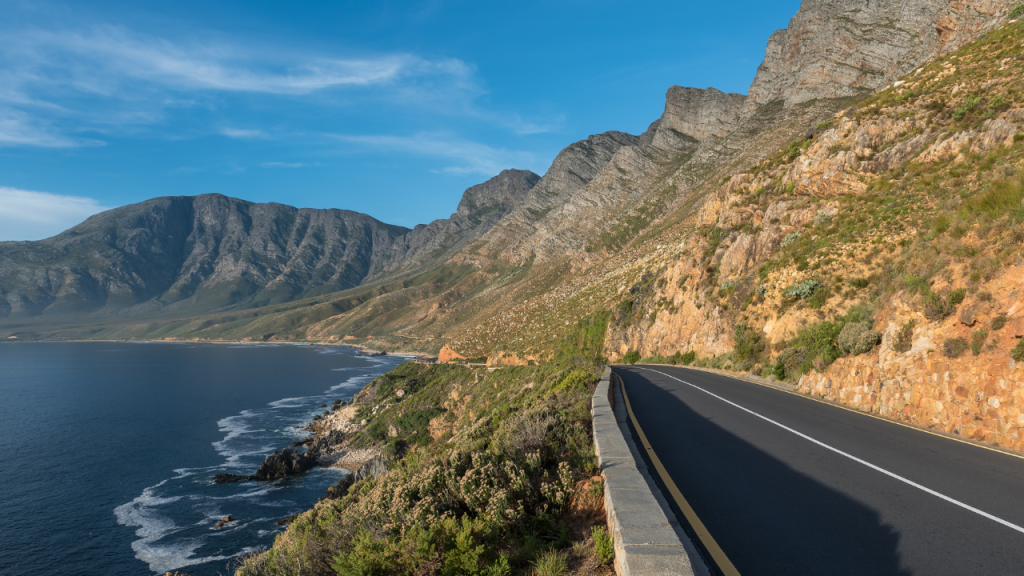
5 Road Trips to Enjoy Over Easter Weekend 2025
Easter Weekend is one of South Africa’s most popular times for adventurous getaways, with local...
 14 April 2025
14 April 2025 
South Africa is a country that’s begging to be explored. Both major attractions and hidden gems are waiting for you around every corner, and self-driving lets you discover this wonderful country at your own pace.
If you’ve driven in South Africa before, you’re probably well-versed in what makes driving in South Africa different, but if it’s your first time, check out this list of 10 essential tips for driving in South Africa.
South Africa uses the British road navigation system, so you’ll need to drive on the left-hand side of the road. The driver’s seat will also be on the right-hand side of the car.

Clarence Drive in South Africa.
If you’re used to driving on the right-hand side of the road, take some time to get used to the difference.
South Africa has a number of toll roads, particularly on its major highways. Be patient at payment points and make sure you’re carrying enough cash, as not all toll booths offer credit/debit card facilities. Tolls contribute to the maintenance of South Africa’s road networks.
South Africa’s rural areas and wilderness areas are hotspots for wildlife crossing the road at all hours of the day. Whether you come across goats, cattle, or even larger animals like elephants, be sure to slow down and give the animals right of way.

Above: Penguin Road Sign, South Africa
Avoid driving at night to minimize your risk of having a wildlife-related accident.
Unlike many other countries, South African fuel stations aren’t self-service. A petrol attendant will fill up your vehicle and it’s good etiquette to give them a small tip (R5 will do) when you’re ready to get going again. Many fuel stations also have convenience stores, so it’s a good idea to stock up on snacks, water and soft drinks while you’re there.
South Africa has strict traffic rules and regulations. Failure to follow them can result in fines and penalties, so it’s best to obey them. Stick to speed limits, obey road signs, and always wear your seatbelt.
There’s not always street lighting outside major cities in South Africa. In addition, the roads can be dangerous at night thanks to pedestrians walking on the shoulder or wildlife crossing the road.

Above: Cederberg in the Western Cape province of South Africa.
Try to limit your driving to daylight hours to ensure your safety.
Follow the advice of traffic reports broadcast on most radio stations. Also check with your accommodation about the conditions of roads in the area, especially if it’s raining. Be aware that traveling on remote roads can get tricky, depending on the weather.
This all depends on your itinerary. If you’re planning on sticking to main roads and cities, a compact car will suit you perfectly.
However, if you’re traveling to more remote destinations like national parks, you might need to hire a 4×4 vehicle to navigate more challenging terrain.
Vehicle crime and petty theft can be a challenge in cities and urban areas. Be sure to keep valuables like cameras and bags out of sight, exercise caution at traffic lights, and park in well-lit areas, preferably patrolled by a parking attendant.
Be sure to have a working phone with a local SIM card. If you’re traveling in more remote areas, it’s a good idea to have a GPS, satellite phone, and map, as not all roads are well signposted and some areas don’t have mobile reception. In case of emergencies, call 10111.

Above: Sunset Scenery with Dust in Kgalagadi Transfrontier Park, South Africa; specie family of
With a bit of planning, some common sense, and a healthy respect for traffic rules and regulations, you’ll be able to enjoy an epic self-drive adventure in South Africa. Explore everything this country has to offer with a rental vehicle from Drive South Africa, Africa’s leading car rental service.